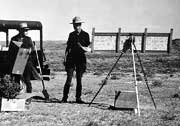 Curator from The Museum of Natural History Clad in Mountain Goat Drag
Curator from The Museum of Natural History Clad in Mountain Goat Drag Can you tell the difference between a chipmunk and a mantled ground squirrel?
 If not, watch the vintage silent movie video " Gettting Our Goat" at the New Dioramas Web site at the Museum of Natural History. Watch the " picket pin " squirrel (incorrectly called a gopher ) nibble nuts proffered by a early Museum naturalist in the field. Watch a scientist stalk a grouse on hands and knees while teams wth pick axes brave the snow " on over the pass" in search of elusive mountain goats. Watch another naturalist dressed up like a mountain goat trying to woo these shy beasts, as he clambers along the edge of cliff and stone, wearing horns and a cute suit that looks like Dr. Denton's pajamas.
If not, watch the vintage silent movie video " Gettting Our Goat" at the New Dioramas Web site at the Museum of Natural History. Watch the " picket pin " squirrel (incorrectly called a gopher ) nibble nuts proffered by a early Museum naturalist in the field. Watch a scientist stalk a grouse on hands and knees while teams wth pick axes brave the snow " on over the pass" in search of elusive mountain goats. Watch another naturalist dressed up like a mountain goat trying to woo these shy beasts, as he clambers along the edge of cliff and stone, wearing horns and a cute suit that looks like Dr. Denton's pajamas. The hand-painted dioramas at Museum of Natural History were the closest New York City children could ever get to virtual reality in pre-Internet days. On any rainy Saturday the Museum's massive halls echoed with the sound of footsteps as children held their parents' hand and stood planted in awe of lions, hippos and other beasts arrayed in front of hand-painted dioramas.

Click here to hear an audio clip of a gorilla's roar and read all about gorillas. Click on the video link and let Curator Steve Quinn lead you on a Video Tour of the Mountain Gorilla Diorama describing diorama artists at work. Watch the video Akeley In Camp on one of the Museum's most gifted diorama artists, who was part of a group of
...brilliant, passionate, and sometimes eccentric artists and naturalists who made the American Museum of Natural History's dioramas include the larger-than-life African explorer and taxidermist Carl Akeley, who survived a bull elephant charge and a leopard attack during his expeditions, which inspired some of the most extraordinary habitat groupings of African wildlife ever seen
 George Petersen and James Perry Wilson on location in Wyoming.
George Petersen and James Perry Wilson on location in Wyoming.Further down on the MNH page find this this video, narrated by Ray de Lucia, which features archival footage of James Perry Wilson at work on the Fisher and Porcupine diorama in the Hall of North American Mammals, we are told.

Richard C. Raddatz (1879-1937)
Radditz joined the staff of the AMNH in 1924,
and was trained by taxidermist Carl Akeley. Raddatz accompanied Akeley on his last expedition to Africa in 1926, collecting foreground accessories. He returned to Africa in 1937 to assist in gathering materials for the ostrich and warthog diorama, when he died of a sudden heart attack in Nairobi, Kenya (then in British East Africa), at the age of fifty-eight.
Click on to view the virtual tours of dioramas. Spin Alaskan Brown Bears and bison around with a click and drag motion of your mouse on the Museum's Quicktime "virtual dioramas".
Explore online this fascinating exhibition devoted to what was once New Yorkers' favorite virtual reality experience... visited offline... in a stately bricks and mortar environment, The Museum of Natural History.
No comments:
Post a Comment